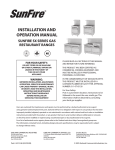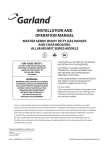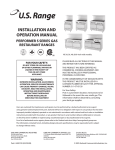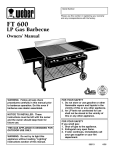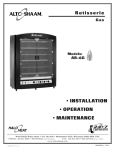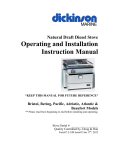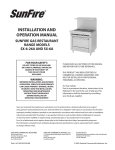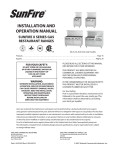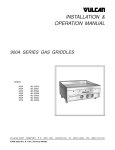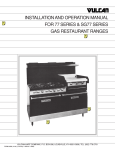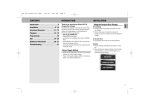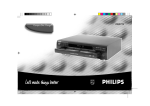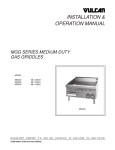Download installation and operating instructions for the sunfire x series gas
Transcript
INSTALLATION AND OPERATING INSTRUCTIONS FOR THE SUNFIRE X SERIES GAS RESTAURANT RANGES FOR YOUR SAFETY DO NOT STORE OR USE GASOLINE OR OTHER FLAMMABLE VAPORS OR LIQUIDS IN THE VICINITY OF THIS OR ANY OTHER APPLIANCE. WARNING: IMPROPER INSTALLATION, ADJUSTMENT, ALTERATION, SERVICE OR MAINTENANCE CAN CAUSE PROPERTY DAMAGE, INJURY OR DEATH. READ THE INSTALLATION, OPERATION AND MAINTENANCE INSTRUCTIONS THOROUGHLY BEFORE INSTALLING OR SERVICING THIS EQUIPMENT. PLEASE READ ALL SECTIONS OF THIS MANUAL AND RETAIN FOR FUTURE REFERENCE. THIS PRODUCT HAS BEEN CERTIFIED AS COMMERCIAL COOKING EQUIPMENT AND MUST BE INSTALLED BY PROFESSIONAL PERSONNEL AS SPECIFIED. For Your Safety: Post in a prominent location, instructions to be followed in the event the user smells gas. This information shall be obtained by consulting your local gas supplier. Users are cautioned that maintenance and repairs must be performed by a Garland authorized service agent using genuine Garland replacement parts. Garland will have no obligation with respect to any product that has been improperly installed, adjusted, operated or not maintained in accordance with national and local codes or installation instructions provided with the product, or any product that has its serial number defaced, obliterated or removed, or which has been modified or repaired using unauthorized parts or by unauthorized service agents. For a list of authorized service agents, please refer to the Garland web site at http://www.garland-group.com. The information contained herein, (including design and parts specifications), may be superseded and is subject to change without notice. Continuous product improvement is a Garland policy, therefore design and specifications are subject to change without notice. GARLAND COMMERCIAL INDUSTRIES 185 East South Street Freeland, Pennsylvania 18224 Phone: (570) 636-1000 Fax: (570) 636-3903 Part Part##XXXXXXX XXXXXXX(02/07) (02/07) GARLAND COMMERCIAL RANGES, LTD. 1177 Kamato Road, Mississauga, Ontario L4W 1X4 CANADA Phone: 905-624-0260 Fax: 905-624-5669 Enodis UK LTD. Swallowfield Way, Hayes, Middlesex UB3 1DQ ENGLAND Telephone: 081-561-0433 Fax: 081-848-0041 © 2007 Garland Commercial Industries,Page Inc. IMPORTANT INFORMATION WARNING: This product contains chemicals known to the State of California to cause cancer and/or birth defects or other reproductive harm. Installation and servicing of this product could expose you to airborne particles of glass wool/ ceramic fibers. Inhalation of airborne particles of glass wool/ceramic fibers is known to the State of California to causes cancer. Operation of this product could expose you to carbon monoxide if not adjusted properly. Inhalation of carbon monoxide is known to the State of California to cause birth defects or other reproductive harm. Keep appliance area free and clear from combustibles Page Part # XXXXXXX (02/07) TABLE OF CONTENTS Important Information . . . . . . . . . . . . . . . . 2 Operation . . . . . . . . . . . . . . . . . . . . . . . . . . 9 Dimensions And Specifications . . . . . . . . . . 4 Open Top burners . . . . . . . . . . . . . . . . . . . . . . . . 9 Gas Pressures . . . . . . . . . . . . . . . . . . . . . . . . . . . . 4 Individual Burner Input Rates . . . . . . . . . . . . . . . 4 Base Model Designations & Total Input Rates. . . 4 Clearances . . . . . . . . . . . . . . . . . . . . . . . . . . . . . . 4 Introduction . . . . . . . . . . . . . . . . . . . . . . . . 5 Rating Plate . . . . . . . . . . . . . . . . . . . . . . . . . . . . . 5 Installation . . . . . . . . . . . . . . . . . . . . . . . . . 5 Siting . . . . . . . . . . . . . . . . . . . . . . . . . . . . . . . . . . 5 Appliances Equipped With Casters. . . . . . . . . . . . 5 Appliances Equipped With Legs. . . . . . . . . . . . . . 6 Installing Shelf To Backguard. . . . . . . . . . . . . . . . 6 Backguard With High Shelves, Salamander Or Cheesemelters Mounting Instructions. . . . . . . 6 Ventilation Air. . . . . . . . . . . . . . . . . . . . . . . . . . . 6 Statutory Regulations. . . . . . . . . . . . . . . . . . . . . . 7 Ovens (Standard). . . . . . . . . . . . . . . . . . . . . . . . . 9 “RC” Convection Ovens. . . . . . . . . . . . . . . . . . . . 9 Hot Top Sections. . . . . . . . . . . . . . . . . . . . . . . . 10 Valve Controlled Griddles. . . . . . . . . . . . . . . . . . 10 Range Shut down. . . . . . . . . . . . . . . . . . . . . . . . 10 Product Application Information . . . . . . . 11 General. . . . . . . . . . . . . . . . . . . . . . . . . . . . . . . . 11 Open Burners. . . . . . . . . . . . . . . . . . . . . . . . . . . 11 Maintenance And Cleaning . . . . . . . . . . . 12 Seasoning. . . . . . . . . . . . . . . . . . . . . . . . . . . . . . 12 Griddle . . . . . . . . . . . . . . . . . . . . . . . . . . . . 12 Cast Iron top Grates . . . . . . . . . . . . . . . . . . 12 Stainless Steel. . . . . . . . . . . . . . . . . . . . . . . . . . . 12 Oven Interior (Porcelain Enamel) Convection Oven Base. . . . . . . . . . . . . . . . . . . . 13 Gas Connection. . . . . . . . . . . . . . . . . . . . . . . . . . 7 Interior Cleaning of Standard Aluminized Steel Interior Surfaces . . . . . . . . . . . 13 Electrical Connections (Where Applicable). . . . . . 7 Open Top Burners . . . . . . . . . . . . . . . . . . . . . . . 13 Installation Notes. . . . . . . . . . . . . . . . . . . . . . . . . 7 Cast Iron Top & Ring Grates. . . . . . . . . . . . . . . 13 Testing And Adjustment . . . . . . . . . . . . . . . 8 Hot Tops . . . . . . . . . . . . . . . . . . . . . . . . . . . . . . 14 Testing. . . . . . . . . . . . . . . . . . . . . . . . . . . . . . . . . 8 Griddle. . . . . . . . . . . . . . . . . . . . . . . . . . . . . . . . 14 Part # XXXXXXX (02/07) Page DIMENSIONS AND SPECIFICATIONS Gas Pressures Gas Minimum Supply Pressure Manifold Operating Pressure Natural 7” WC (17.5 mbar) 4.5” WC (11.25 mbar) Propane 11” WC (28 mbar) 10” WC (25 mbar) Individual Burner Input Rates Input BTU/HR Burner Natural Gas Propane Gas Open Top 30,000 30,000 Hot Top Burner (In lieu of 2 open top burners) 20,000 19,000 Griddle Burner (In lieu of 2 open top burners) 20,000 19,000 Oven Burner Standard or Convection 33.000 30,000 Base Model Designations & Total Input Rates Model # Input BTU/Hr Description Natural Gas Propane Gas X36-6S 36” (914mm) unit, 6 open burners, storage base 180,000 180,000 X36-6R 36” (914mm) unit, 6 open burners, standard oven 213,000 213,000 X36-6C 36” (914mm) unit, 6 open burners, convection oven 213,000 213,000 X60-10SS 60” (1524mm) unit, 10 open burners, storage base 300,000 300,000 X60-10RS 60” (1524mm) unit, 10 open burners, standard oven 333,000 333.000 X60-10CS 60” (1524mm) unit, 10 open burners, convection oven 333,000 333,000 X60-10CR 60” (1524mm) unit, 10 open burners, standard oven, convection oven 366,000 366,000 X60-10RR 60” (1524mm) unit, 10 open burners, 2 standard ovens 366,000 366,000 X60-10CC 60” (1524mm) unit, 10 open burners, 2 convection ovens 366,000 366,000 Clearances Clearances Applicable For All Models Page Surface Sides Rear Combustible Wall Minimum 12” (305mm) 6” (152mm) Non-Combustible Wall Minimum 0” 0” Part # XXXXXXX (02/07) INTRODUCTION 1. Check crate for possible damage sustained during transit. Carefully remove unit from crate and again check for damage. Any damage to the appliance must be reported to the carrier immediately. 4. The type of gas and supply pressure that the equipment was set-up for at the factory is noted on the rating plate and on the packaging. This type of gas supply must be used. 2. The wires for retaining packing material must be removed from units. Any protective material covering stainless steel parts must also be removed. 5. Do not remove permanently affixed labels, warnings or rating plates from the appliance, for this may invalidate the manufacturer’s warranty 3. All equipment is shipped from the factory with legs fitted, unless otherwise specified. Where the range is to be mounted on a dais or cove base, it is shipped without legs. Legs must be fitted to the oven when it is installed on a combustible floor. Rating Plate All burner input rates are shown on the rating plate, which is located behind the lower front drop down panel under the oven door. INSTALLATION This product has been certified as commercial cooking equipment and must be installed by professional personal as specified. THIS APPLIANCE IS NOT RECOMMENDED FOR RESIDENTIAL INSTALLATION. We suggest installation, maintenance and repairs should be preformed by your local Garland/US Range authorized service agency. Siting The floor on which the appliance is to be sited must be capable of adequately supporting the weight of the appliance and any ancillary equipment. Units with ovens must be fitted with legs if installed on a combustible floor. Adequate clearance must be provided for servicing and proper operation. Part # XXXXXXX (02/07) Appliances Equipped With Casters 1. The installation shall be made with a connector that complies with the Standard for Connectors for Moveable Gas Appliances, ANSI Z21.69, (or latest edition), addenda Z21.69a-1989, or Connectors for Moveable Gas Appliances, CAN/CGA-6-16 or latest edition, and a quick-disconnect device that complies with the Standard for Quick Disconnects for Use with Gas Fuel, ANSI Z21.41 or latest edition, or Quick Disconnect Devices for Use with Gas Fuel, CAN1-6.9 or latest edition. 2. The front casters of the appliance are equipped with brakes to limit the movement of the appliance without placing any strain on the connector or quick disconnect device or its associated piping. 3. Please be aware; required restraint is attached to a bracket, (which is located on the rear of the caster closest to the gas connection), and if disconnection of the restraint is necessary, be sure to reconnect the device after the appliance has been returned to its original position. Page INSTALLATION Continued Appliances Equipped With Legs 1. Raise the front of the appliance and block. Do not lay the appliance on its back. 2. Legs are threaded to be easily threaded into the holes provided on the bottom of the range. 3. Once legs have been attached and secured they can be adjusted up level the appliance to compensate for uneven flooring. Installing Shelf To Backguard Backguard With High Shelves, Salamander Or Cheesemelters Mounting Instructions 1. Rear of the range must be easily accessible 2. Place the backguard, high shelf, salamander, or cheesmelter on the rear of the range, slipping the support brackets into the openings in the burner box sides. 3. Securely fasten the support brackets to the burner box sides with (4) #14 x 5/8” Hex washer head, type B tapping screws. (Hardware package is supplied). Note: Shelf may be installed before or after installing the backguard to the range. Upright 1. Loosen 4 bolts on the front of the backguard approximately 1/4” (6mm). 2. Align the 4 holes on the back of the shelf with the 4 bolts on the backguard. Burner Box Side 3. Slide the shelf downward until the 4 bolts are engaged in the slotted portion of the keyhole. 1/4" x 3/4" Type "B" Washer Hex Head SMS 4 Req'd 4. Tighten the 4 bolts to secure shelf. 5. On 60” units only, install a sheet metal screw though the hole in the underside of the shelf into the backguard and tighten. Ventilation Air MOUNTING BOLTS SHELF SHEETMETAL SCREW BACKGUARD The following notes are intended to give general guidance. For detailed recommendations, refer to the applicable code(s) in the country of destination. Proper ventilation is highly essential for optimum performance. The ideal method of ventilating open-top equipment is the use of a properly designed canopy that should extend six inches (152 mm), beyond all sides of the appliance(s) and six feet, six inches (1981mm) above the floor. A strong exhaust will create a vacuum in the room. For an exhaust vent to work properly, replacement air must equal to the amount exhausted. Page Part # XXXXXXX (02/07) INSTALLATION Continued All gas burners and pilots need sufficient air to operate. Large objects should not be placed in front of the appliance(s) that would obstruct the flow of air into the front Statutory Regulations The installation of this appliance must be carried out by a competent person and in accordance with the relevant regulations, codes of practice and the related publications of the country and destination. The installation must conform to the National Fuel Gas Code ANSI Z223.1, or latest edition, NFRA No.54 - latest edition/or local code to assure safe and efficient operation. In Canada, the installation must comply with CSA B149.1 and local codes. Gas Connection The local gas authority should be consulted at the installation planning stage in order to establish the availability of an adequate supply of gas and to ensure that the meter is adequate for the required flow rate. The pipe work from the meter to the appliances must be of an appropriate size. All fixed (non-mobile) appliances MUST be fitted with a manual gas-cock upstream of the appliance to provide a means of isolation for servicing or cleaning purposes. A union or similar means of disconnection must be provided between the gas-cock and the appliance. A manually operable valve must be fitted to the gas supply to the kitchen to enable it to be isolated in an emergency. Wherever practical, this shall be located either outside the kitchen or near to an exit in a readily accessible position. Where it is not practical to do this, an automatic isolation valve system shall be fitted which can be operated from a readily accessible position near to the exit. At locations where the manual isolation valve is fitted or the automatic system can be reset a notice MUST be posted stating: “ALL DOWNSTREAM BURNER AND PILOT VALVES MUST BE TURNED OFF PRIOR TO ATTEMPTING TO RESTORE THE SUPPLY. AFTER EXTENDED SHUT OFF, PURGE BEFORE RESTORING GAS.” Electrical Connections (Where Applicable) IMPORTANT- This appliance must be electrically grounded in accordance with local codes, with the National Electrical Code. 220/240 Volt Convection Oven Models When the appliance is ordered and equipped for 220/240 volt operation, the supply line must be connected to the wiring terminations located inside the terminal box at the rear of the appliance. For ease of attaching the supply line, there is a removable cover on the terminal box. Permanent connection to the electrical service must comply with local codes, or in the absence of local codes, with the national electrical code. Installation Notes Before assembly and connection check gas supply. A. The type of gas for which the unit is equipped is stamped on the data plate located behind the lower front panel. Connect a unit stamped “NAT” only to natural gas; connect one stamped “PRO” only to propane gas. B. If it is a new installation have the gas authorities check meter size and piping to assure that the unit is supplied with necessary amount of gas pressure required to operate the unit. C. If it is additional or replacement equipment have the gas authorities check pressure to make certain that existing meter and piping will supply fuel to the unit with no more than 0.15 Kpa pressure drop. Part # XXXXXXX (02/07) Page INSTALLATION Continued D. Make certain new piping and connections have been made in a clean manner and have been purged so that piping compound, chips, etc. will not clog pilots, valves or burners. Use pipe joint compound approved for natural and liquefied petroleum gases. NOTE: Gas pressure should be checked when the unit is installed and all other equipment on the same line is on. The operating gas pressure must be the same as that specified on the rating plate. If necessary, pressure adjustment may be made at the pressure regulator supplied with the appliance. The appliance and its individual shut-off valve must be disconnected from the gas supply piping system during any pressure testing of that system pressures in excess of 1/2 PSIG (3.45kPa.) TESTING AND ADJUSTMENT Testing 4. Light the oven pilot. All fittings and pipe connections must be tested for leaks. Use approved gas leak detectors, soap solution or equivalent, checking over and around all the fittings and pipe connections. DO NOT USE A FLAME! Accessibility to all gas lines and fittings require that valve panel(s) lower front panel(s), and/or oven rack(s) be removed. It may be necessary to remove, or at least raise and securely prop griddle(s), hot top(s), and/or top grate(s). All parts removed, (including fasteners), should be stored safely for re-installation. 5. In either case, now set the oven thermostat to maximum. Leak test all valves and fittings as described at the beginning of this section. Correct any leaks as required and recheck. 1. Be sure that all valves and thermostats are in the “OFF” position. 2. Turn on the main gas supply valve. Light all top section pilots. 3. Leak test all valves and fittings as described at the beginning of this section. Correct any leaks as required and recheck. Page 6. Shut off all valves and set thermostat dials to “OFF” or lowest position. All units are tested and adjusted at the factory, however, burners and pilots should be checked upon installation and adjusted if necessary. CAUTION: Gas will flow to the top section burners even if top section pilots are not lit. Gas will not be interrupted. It is the responsibility of the operator to confirm the proper ignition of each burner as it is turned on. Should ignition fail to occur 5 seconds after turning a burner on, turn the burner off, wait 5 minutes, and try again. Part # XXXXXXX (02/07) OPERATION Open Top burners Lighting: 1. Light pilots are adjacent to each burner. 2. Turn valve completely on. Burner flame should be 1/2-inch, (13mm), stable blue flame, and should impinge on the bottom of a pot placed on the ring great. CAUTION: Should burner ignition fail within 4 seconds, turn the burner valve off and repeat steps 1 through 2. If ignition continues to fail, consult your factory authorized service agency. CAUTION: Gas will flow to the top section burners even if top section pilots are not lit. Gas will not be interrupted. It is the responsibility of the operator to confirm the proper ignition of each burner as it is turned on. Should ignition fail to occur 5 seconds after turning a burner on, turn the burner off, wait 5 minutes, and try again. Ovens (Standard) Lighting 1. Push in the valve knob, and turn it counterclockwise to the ignition position. 2. While holding the valve knob fully in, press the ignitor button and observe that the pilot lights. If it does not, repeatedly depress the ignition button until it does. 3. When the pilot is lit, continue to hold the valve knob fully in for 10 seconds, then release it. If the pilot goes out, wait for five (5), minutes, then repeat step 1. 6. To shut the burner and pilot completely off turn the dial to the off symbol position. The safety device will disengage within 60 seconds. Convection Ovens The forced air range oven consists of a food preparation chamber completely sealed from the combustion area. This eliminates the possibility of contamination from flue products and permits an efficient method of circulating the heated air within the cooking chamber. During the cooking process in a conventional oven, a vapor barrier and a layer of “cool” air covers the exposed area of the product. In a forced air oven, the fan pushes the heated air over and around the product, sweeping away the vapor barrier and cool air, permitting faster heat penetration. This action permits the use of lower temperatures and shorter cooking times. The rule of thumb for determining the cooking temperature is to reduce the set temperature by approximately 80°F, (28°C), from that which you would set in a conventional oven, and that the product be checked at a point midway in the time required in a conventional oven. Lighting Refer to the section titled “OVENS (STANDARD)” above for detailed instructions. Start Up 1. Set the power switch to the “COOK” position. 2. Turn the oven valve knob to the “flame” symbol. 3. Turn the thermostat to the desired setting. Cool down 4. When the pilot has been established, turn the knob counter-clockwise to oven flame position, then set the thermostat to the desired temperature. 1. Turn the oven valve knob to the circular “OFF”. 5. To keep the main burner flame closed and but the pilot flame lit turn the control knob to the pilot position. Do not push into knob. 3. Open the oven door. Part # XXXXXXX (02/07) 2. Turn the thermostat to its lower setting. 4. Set the power switch to the “COOL DOWN” position. Page OPERATION continued Shut Down Hot Top Sections 1. Turn the oven valve knob to the circular “OFF” symbol. 1. Raise or remove hot top sections. Each burner has one pilot located at the front right side of the burner. 2. Turn the thermostat to its lowest setting. 3. Set the power switch to the “OFF” position. Operating Suggestions The motor on your range convection oven is maintenance free since it is constructed with self-lubricating sealed ball bearings. It is designed to proved durable service when treated with ordinary care. We have a few suggestions to follow on the care of your motor. A. When the motor is operating, it cools itself internally by air entering the rear of the motor case, provided proper clearance has been allowed. B. Since the blower wheel is in the oven cavity it is at the same temperature as the oven. If the motor is stopped while the oven is hot, the heat from the blower wheel is conducted down the shaft and into the armature of the motor. This action could shorten motor life. C. We recommend, at the end of the bake or roasting period, when the oven will be idle for any period of time or before shutting down completely, that the doors be left open, and by use of the cool-down position on the fan switch, the fan continues to run for at least 20 minutes. The “FAN” should never be turned “OFF” when the oven is “HOT”. Page 10 2. Light pilots. The pilot burner should be adjusted to provide for rapid ignition of the burner. 3. Turn the burner valve on. A sharp blue flame should be approximately 1/4-inch, (6mm), high. 4. Replace hot top sections. Valve Controlled Griddles See griddle seasoning before use. 1. Raise griddle at front and securely block. 2. Light pilots located at the front right side of each burner. 3. Turn burner valves completely on. Burners should have 1/2-inch to 5/8-inch, (13mm to 16mm), stable blue flame. 4. Lower griddle carefully into position. Range Shut down 1. Turn all valves to the “OFF” position. 2. If the unit is to be shut down for an extended period of time, close the in-line gas valve. Part # XXXXXXX (02/07) PRODUCT APPLICATION INFORMATION General The range is the workhorse of the kitchen because of its versatility. Most frequently used in small applications, such as cafes, schools, church kitchens, firehouses, and small nursing homes where demands are less taxing. As a general rule of thumb, one four to six burner range with a hot top will be adequate for a restaurant seating 30 to 35. The top of the range is designed for flexibility and the preparation of numerous different types of products. It may be equipped with two, or even three different types of tops and burners, depending on the menu needs. An operation that cooks to order, or uses the range primarily as back-up will find that open burners will suit most of their needs. Preparation of soups, stocks, or sauces is done on a hot top where slow, even cooking in desirable. Heating larger quantities of food can be done more efficiently than heating small quantities. Pots and pans should be covered whenever possible to reduce energy consumption. Part # XXXXXXX (02/07) High acid sauces, such as tomato should be cooked in stainless steel rather than aluminum to avoid chemical reaction. Light colored sauces such as Alfredo may be discolored by the use of aluminum, especially if stirred with a metal spoon or whip. Saltwater shellfish may pit aluminum pots if they are frequently used for this purpose. NOTE: Many parts of the commercial range are raw steel. Hot tops, griddles, springs, door hooks etc., can react with the moisture forming rust. This occurrence is normal and not considered a defect. Clean with a stainless steel or fiber pad. A light coating of cooking oil may be applied. Open Burners The mist traditional uses of open burners are sautéing, pan frying, and small stock pot work. Short-term cooking is the most efficient use for the open burner. Pans should cover as much of the grate as possible to minimize heat loss. The maximum stop pot size to be used on an open burner is 11 inches, (279mm), diameter. Open burners should be turned off when not in use to conserve energy. Leaving a flame burning is of no advantage since the heat is instantaneous. Page 11 MAINTENANCE AND CLEANING Seasoning Griddle A. Remove all factory applied protective material by washing with hot water, mild detergent or soap solution. B. Apply a thin coat of cooking oil to the griddle surface, about one ounce per square foot of griddle surface. Spread over the entire griddle surface with a cloth to create a thin film. Wipe off any excess oil with a cloth. C. Light all burners, set a lowest possible setting. Some discoloration will occur when heat is applied to steel. D. Heat the griddle slowly for 15 to 20 minutes. Then wipe away oil. Repeat the procedure 2 to 3 times until the griddle has a slick, mirror like finish. Do this until you have reached the desired cooking temperature. IMPORTANT: Do not attain high (on valve control) during “break-in” period NOTE: Steel griddle surface will tone (blue discoloration) from heat. This toning will not diminish function or operation is not a defect. The griddle will not require reseasoning if it is used properly. If the griddle is over heated and product begins to stick to the surface it may be necessary to repeat the seasoning process again. If the griddle is cleaned with soap and water it will be necessary to reseason the griddle surface. Cast Iron top Grates First, remove the cast iron top grates from the range. Wash the cast iron top grates thoroughly with a mild soap and warm water. Dry the cast-iron top grates thoroughly with a clean cloth. Immediately after drying, season the top grates lightly with a non-toxic oil, (Liquid vegetable oil or Pam spray oil) WARNING; DO NOT SEASON THE TOP GRATES WHILE ON THE RANGE TOP! Page 12 Seasoning grates on the range top over an open flame could cause a flash fire. After seasoning, replace the top grates onto the range. Turn all the range top sections “ON LOW”. Allow the top sections to burn in this manner for at least 20 minutes before using pots or pans on the top grates. SEASONING OF THE TOP GRATES WILL BE REQUIRED WHENEVER THEY HAVE BEEN CLEANED. FAILURE TO SEASON GRATES WILL CAUSE RUSTING. Stainless Steel For routine cleaning just wash with a hot water and detergent solution. Wash just a small area at a time or the water will evaporate leaving the chemicals behind causing streaking. Rinse the washed area with a clean sponge dipped in a sanitizing solution and wipe dry with a soft clean cloth before it can dry. Use a paste (of water and a mild scouring powder) if you have to, but never rub against the grain. All stainless steel has been polished in one direction. Rub with the polish lines to preserve the original finish. Then thoroughly rinse as before. To prevent fingerprints there are several stainless steel polishes on the market that leave an oily or waxy film. Do not use on surfaces that will be in contact with food. Stainless steel may discolor if overheated. These stains can usually be removed by vigorous rubbing with a scouring powder paste. Use only stainless steel, wood or plastic tools if necessary to scrape off heavy deposits of grease and oil. Do not use ordinary steel scrapers or knives, as particles of the iron may become imbedded and rust. STEEL WOOL SHOULD NEVER BE USED. Either a typical bleach solution or hot water can be used to sanitize stainless steel Part # XXXXXXX (02/07) MAINTENANCE AND CLEANING Continued Oven Interior (Porcelain Enamel) Convection Oven Base NOTE: Disconnect line cord (if applicable from power supply before cleaning or servicing. 1. Before cleaning oven interior, remove all oven racks and guides. Oven racks and guides can be cleaned with a mild soap and warm water or run through dish washer. 2. The porcelain interior can be cleaned with oven cleaners such as “Easy Off, or “Dow Oven Cleaner”. Follow product manufacturer’s instructions for proper use Interior Cleaning of Standard Aluminized Steel Interior Surfaces The oven sides and top linings are formed of heavy gauge steel with an aluminum fused into its surface to provide for the reflectance of heat back to the food being prepared and to virtually eliminate the possibility of rust formation. Establish a regular cleaning schedule or wipe off on the same day when spillovers occur. 1. Cool down oven. 2. Remove oven racks. 3. Lift rack guides on either side of oven off of holders, pull the top away from the cavity wall, when it’s cleared the clips push down and remove. Racks and guides may be run through dishwasher while oven cavity is being cleaned. 4. Use a concentrated detergent on a plastic pad to remove burned on soil. Do Not Use Steel Wool, Oven Cleaner Or Abrasive Powders. These will remove the aluminum. Rinse with warm water on a soft cloth. Be sure to remove all traces of detergent. Any discoloration, which may remain after the soil build-up has been removed, will not affect the performance of the oven. Part # XXXXXXX (02/07) 5. To reinstall reverse procedure. Place the bottom of the rack guide against the cavity wall. Keeping the top pulled away from the wall lift up. Push the top of the rack guide against the wall and push down locking it into place. Open Top Burners Cleaning of the range top burner is a simple procedure, and, if done at regular intervals will prolong the life of the range and ensure good flame characteristics. 1. The most common problem with open burner ranges is spillage. Once the burner ports are partially plugged with food, the air-to-gas mixture is disturbed and results in an inefficient burner. 2. Wipe any spills as they occur. 3. Grids and trays should be removed daily, washed, rinsed and dried thoroughly. 4. Use a wire brush to clean the ports of the burners. Ignite and check for clogged holes. 5. If any clogged holes are apparent, the burner should be lifted out and brushed inside and out with a small venture brush. Each port on the burner itself should be cleaned with a properly sized wire or thumb drill. Wash with soap and hot water if grease is observed on the burners. Dry thoroughly. 6. Reinstall and check the flame pattern. Readjust the air shutter if necessary. 7. If a yellow flame appears around the edges instead of being uniformly blue, it is usually a sign of grease and dirt in the throat of the burner. Remove and clean the burner and readjust the air shutter Cast Iron Top & Ring Grates Cast iron top and ring rate(s) can be cleaned with mild soap and warm water. For baked on material, a wire brush can be used. Dry thoroughly. Lightly coat with vegetable oil to help prevent rust from forming. Page 13 MAINTENANCE AND CLEANING Continued Hot Tops While the surface is still slightly warm, wipe down with a clean burlap cloth. Burnt on spillage should be scraped off. If necessary, remove the plate and wash in a sink with soap and hot water. Dry thoroughly. In damp climates, wipe down with a light coating of oil to prevent rusting. Avoid excessive use of water at this could damage the surface and the controls below. NOTE: Steel griddle and hot top surface will “tone” (blue/brown discoloration) from heat. This toning will not diminish function or operation and is not a defect. Griddle To produce evenly cooked, browned griddle products, keep griddle free from carbonized grease. Carbonized grease on the surface hinders the transfer of heat from the griddle surface to food product. This results in uneven browning and loss of cooking efficiency, and worst of all, carbonized grease tends to cling to grilled foods, giving them a highly unsatisfactory and unappetizing appearance. To keep the griddle clean and operating at peak performance, follow these simple instructions: A. AFTER EACH USE clean griddle thoroughly with a grill scraper or spatula. Wipe off any excess debris left from cooking process. Page 14 B. ONCE A DAY clean griddle surface with a grill brick and grill pad. Remove grease container and clean thoroughly, in same manner as any ordinary cooking utensil. C. ONCE A WEEK clean griddle surface thoroughly. If necessary, use a grill stone or grill pad over the griddle surface. Rub with grain of the metal while still warm. A detergent may be used on the plate surface to help clean it, but care must be taken to be sure it is thoroughly removed. After removal of detergent, the surface of the plate should be covered with a thin film of oil to prevent rusting. To remove discolorations, use a non-abrasive cleaner. Before re-using, the griddle must be reseasoned. Keep griddle drain tube to grease container clear at all times on those models without grease container. CAUTION This griddle plate is steel, but the surface is relatively soft and can be scored or dented by careless use of spatula. Be careful not to dent, scratch, or gouge the plate surface. This will cause food to stick in those areas. Also, note, since this is a steel griddle if a light coating of oil is not always present rust will develop on exposed and uncoated areas. Part # XXXXXXX (02/07) NOTES Part # XXXXXXX (02/07) Page 15
















